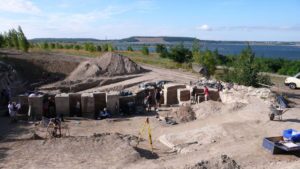
120,000 BP, present-day Germany —Picture a small group of Neanderthals strategizing their movements to approach a young, male antlered deer and then, when the right moment and positioning arrives, quickly and lethally thrusting a sharp wooden spear into their victim in a coordinated effort to bring home their game. It is a good day for these hunters.
This could be a scenario based on new evidence that emerged through the re-analysis of ancient faunal remains recovered from the archaeological site of Neumark-Nord near Halle in present-day Germany, a site which featured animal fossil remains with cut marks and artifacts to which archaeologists have attributed to Neanderthals. Neumark-Nord consists of several ancient lake basins with deposits, including lithic artifacts and faunal remains, that record human activity for the past 400,000 years. Pertinent to the latest study*, wherein Sabine Gaudzinski-Windheuser of the MONREPOS Archaeological Research Center and Museum for Human Behavioral Evolution and colleagues applied microscopic imaging and experimental ballistic tests, the site also held ancient lake-shore deposits dated to 120,000 BP, an interglacial time when the lake was surrounded by closed-canopy forests. The deposits contained fossil fragments and disarticulated as well as articulated skeletal remains, including straight-tusked elephants and cervids (mammals of the deer family). Four of the cervids, complete or nearly complete male fallow deer, featured very fine cut marks that penetrated the outermost layer of the bones, indicating partial defleshing of the rump, haunch and shoulder areas through butchering. Most significant among them, however, was the skeleton of a 6-7-year-old adult male found lying on its right side, showing a circular perforation in the pelvis; and that of another 6-7-year-old male showing a perforation with a circular outline in one of its cervical vertebra. The researchers characterized these perforations as almost unmistakable hunting lesions. Moreover, “the size, shape and fracture characteristics of the perforations look to be well-matched to wooden spears of the kinds seen at Clacton-on-Sea in Britain and Schöningen and Lehringen in Germany,” writes Annemieke Milks** in a news report of the Gaudzinski-Windheuser et al. study published in the journal, Nature Ecology and Evolution. Study of the perforations also revealed that they were caused by close-range thrusting actions, as opposed to longer-range strikes through throwing or propelled projectiles.
_______________________________

Excavation of a 120,000 last Interglacial lake-landscape at Neumark-Nord near present day Halle in the eastern part of Germany by the Archaeological Research Center and Museum for Human Behavioral Evolution MONREPOS and the Faculty of Archaeology of Leiden University supported by supported by the heritage office of Saxony Anhalt (Germany). Picture credit: W. Roebroeks, Leiden University (NL), j.w.m.roebroeks@arch.leidenuniv.nl
______________________________
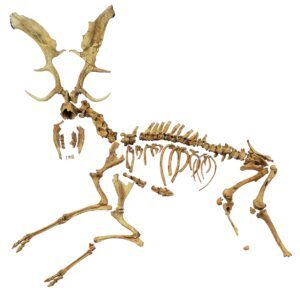
Skeleton of an extinct fallow deer (Dama dama geiselana) from Neumark-Nord, arranged in flight-posture. Foto Juraj Lipták. © Landesamt für Denkmalpflege und Archäologie Sachsen-Anhalt, Juraj Lipták. BStoll-Tucker@lda.stk.sachsen-anhalt.de
________________________________
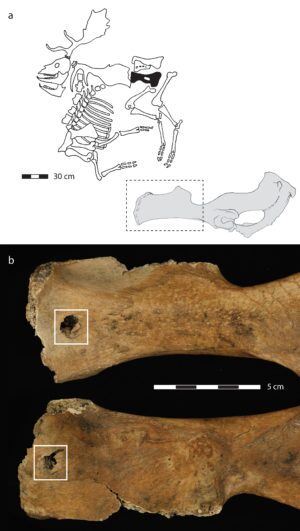
Front and back view of a hunting lesion in the pelvis of an extinct fallow deer, killed by Neanderthals 120,000 years ago on a lake shore close to current-day Halle (Germany). Picture credit: Eduard Pop, MONREPOS Archaeological Research Center and Museum for Human Behavioral Evolution, Römisch-Germanisches Zentralmuseum, Leibniz-Researchinstitute for Archaeology, eduard.pop@rgzm.de
_____________________________
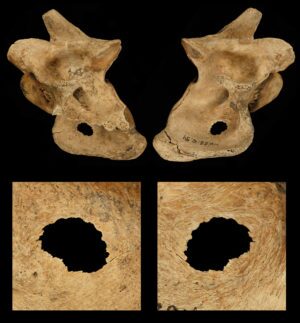
Front and back view of a hunting lesion in a cervical vertebra of an extinct fallow deer, killed by Neanderthals 120,000 years ago on a lake shore close to current-day Halle (Germany). Picture credit: Eduard Pop, MONREPOS Archaeological Research Center and Museum for Human Behavioral Evolution, Römisch-Germanisches Zentralmuseum, Leibniz-Researchinstitute for Archaeology, eduard.pop@rgzm.de
________________________________
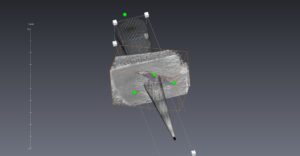
Micro-CT scans of the lesion in the pelvis of a fallow deer, killed 120,000 years ago on a lake shore close to current-day Halle (Germany). The screenshots show lesion and reconstructed form of the pointed object (spear) which caused the perforation, seen from its exit side. Pictures credit: Arne Jacob & Frieder Enzmann, Johannes Gutenberg-University Mainz, Germany, ajacob@students.uni-mainz.de, enzmann@uni-mainz.de
_________________________________
Neanderthal Hunting
Although scientists have long suggested that Neanderthals were skilled hunters, including the use of spears, the significance of the Neumark-Nord findings lies in the fact that hunting lesions are very rare in the archaeological record, and the perforations on these assemblages were unusually complete, facilitating better and more reliable forensic analysis “with the demonstrated impact angles and wound channels particularly convincing”.** Additional application of experimental techniques to replicate the lesions also verified their conclusions. In short, the study confirmed “the earliest unambiguous examples of hunting lesions”** in the archaeological record using thorough and updated analysis and techniques, and that these Neanderthals used close-range thrusting to kill their prey. It means that Neanderthals could hunt in closed, forested landscapes, suggesting complex hunting strategies and cooperative behavior.
Nonetheless, although analysis of the lesions indicated that the apparent weapon impact energy was more consistent with that produced by close range thrusting, writes Milks, “how energies compare and potentially overlap between these delivery methods [thrusting or throwing] is still being established experimentally”.** Neanderthals, therefore, could have used both close-range hunting and throwing as delivery methods for bringing down and killing their prey.
“If future work can focus on building a picture of how these weapons perform when thrown,” writes Milks, “we will be better able to understand whether early weapons and weapon users were optimized only for thrusting, or for throwing as well.”**
_____________________________
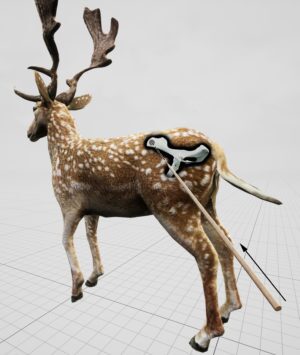
Estimated impact angle shown in relation to a standing fallow deer for the hunting lesion observed in the pelvis of an extinct fallow deer, killed by Neanderthals 120,000 years ago on a lake shore close to current-day Halle (Germany). Picture credit: Eduard Pop, MONREPOS Archaeological Research Center and Museum for Human Behavioral Evolution, Römisch-Germanisches Zentralmuseum, Leibniz-Researchinstitute for Archaeology, eduard.pop@rgzm.de
_____________________________

A 300,000-year-old wooden spear from Schöningen 13/II (Germany). Neanderthals might have used a similar weapon to kill fallow deer at Neumark-Nord, on a lake shore close to current-day Halle (Germany), 120,000 years ago. © R. Müller, Römisch-Germanisches Zentralmuseum, Leibniz-Forschungsinstitut für Archäologie, mueller@rgzm.de
_____________________________
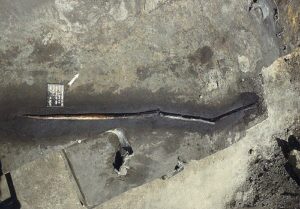
Spear 8 in situ as excavated at Schoningen. Wikimedia Commons
_____________________________
*Sabine Gaudzinski-Windheuser et al., Evidence for close-range hunting by last interglacial Neanderthals, Nature Ecology and Evolution, doi.org/10.1038/s41559-018-0596-1
**Milks, Annemieke, Making an Impact, Nature Ecology and Evolution News and Views, June 25, 2018.
_____________________________
Join us on this incredible journey!




